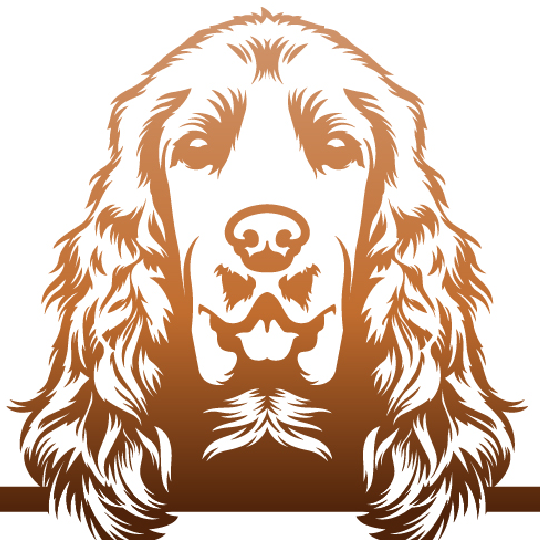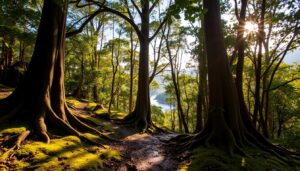For many a pet parent, the phrase “Let’s go for a walk!” usually results in a tail-wagging, leash-grabbing dance of joy. But when your furry sidekick hits the brakes, the daily stroll can quickly become a test of wills. There you are, facing the all-too-common conundrum of overcoming dog walking refusal. Why, oh why, does your four-pawed pal suddenly morph into a statue?
Mel from Gold Coast’s All For Furry Friends is no stranger to the reluctant dog walking blues. According to this well-heeled walking wizard, your pooch’s pause could be down to anything from an ouch-inducing joint pain, a gnawing undetected injury, to the terror of the unknown that’s secretly freaking Fido out. Or perhaps it’s the beginner’s bungle—a lack of proper leash training. Emulating a tug-of-war pro is not the solution—nope, not even the teensiest bribe or drag—because savvy dog walking calls for finesse and understanding.
Key Takeaways
- Joint pain or injury may cause a dog to halt in their tracks.
- Fear and anxiety are significant factors in reluctant dog walking.
- Leash training is crucial for acclimating dogs to walking routines.
- Dragging or bribing your dog when they refuse to walk can worsen the issue.
- Address walking issues with patience, strategy, and zero brute force.
Understanding Your Dog’s Walking Refusal
Is your four-legged friend giving you the cold shoulder when it’s walkies time? Well, buckle up buttercup, because we’re about to crack the code on dog walking resistance. The Sherlock in you must spring into action because those paws aren’t going to move themselves!
First off, think of yourself as a detective in a who-done-it canine thriller. You witness the case of the static dog; you know, the one that transforms into a furry boulder mid-walk. Before you get tangled in the leash of confusion, let’s look closely at the reasons your dog doesn’t like walks. It could be a game-changer in turning your walk into a stride of pride instead of a drag of dread.
Recognizing Signs of Resistance During Walks
It’s as plain as the nose on your pup’s face. Spotting signs of resistance isn’t rocket science—it’s dog science. A pooch planted firmly on the pavement is a telltale sign. Some may even give the old “talk to the paw” with a stubborn yank back on the leash. Not to fret, Nancy Drew of dog dilemmas, we can sniff out the mystery behind those paused paws.
Common Behaviors of a Reluctant Walker
Behaviors of a reluctant rover aren’t always as loud as a bark in a quiet room. Some are subtle, like a low whine or a crafty crouch. Sometimes they’re loud and clear—a yelp, a whine, or heavy breathing, ready to send you on a guilt trip for dragging them out of their cozy corner. Noticing these quirks is your first clue in the case of how to motivate your dog for a walk.
Initial Assessment of Your Dog’s Walking Habits
Now it’s time to roll up your sleeves and delve into the initial assessment. Break out the magnifying glass and observe your pupper’s every move. How do they react when you say “walk”? Is there a lightning-speed dart for cover, or perhaps a lumbering approach that screams reluctance? Getting to the bottom of your dog’s walking blues will soon lead you to mastering the art of the enjoyable canine promenade.
Is Your Dog in Pain? Joint Issues and Walking Reluctance
When Fido flinches from flânerie, it might be more than a stubborn streak. If your dog doesn’t want to walk, it could be a cry for help rather than canine caprice. Those cute creatures can’t exactly chirp out, “Pal, I’ve got joint pain,” now can they? The four-legged stoicism can sometimes mask hurts that halt the once joyful jaunts. Let’s decode the doggo distress signals together!
Spotting Symptoms of Joint Pain in Dogs
Observing our four-legged friends for signs of discomfort is more art than science. A limp here, a lag there, or the dreaded yelp that shivers the heartstrings—it’s their non-verbal nudge nudging us towards the pain puzzle. Joint pain in pets often goes unnoticed until it’s advanced enough to lead to a clear halt in walkabouts. So keep your peepers peeled for pained paws, limbs less limber, and a reluctant rover rooted in place.

Arthritis and Hip Dysplasia: How They Affect Mobility
Two notorious nemeses of noble strides in our canines are the dastardly duo of canine arthritis and hip dysplasia in dogs. These maladies are like the dour dance partners no dog wishes to tango with. They bring forth a sloth in the spirited, making a mosey down the lane morph into a mortifying meander. When joints come to joust with these jerks, your dog’s energetic escapades could quickly become tales of yore.
| Condition | Symptoms | Effects on Walks |
|---|---|---|
| Canine Arthritis | Limping, stiffness post-rest, swollen joints | Reluctance to walk, reduced activity, stopping mid-walk |
| Hip Dysplasia | Favoring one leg, difficulty rising, loss of thigh muscle | Avoidance of stairs/steps, hesitancy to jump or play |
The tableau above paints the picture of pooch problems that could curtail the canine commute. Spot these trespassers early, and you can teach them the equivalent of fetch—where you throw them far away from your dog’s delight in daily walks. And remember, if you spy these signs, a vet should be your next venue. Consult the professionals, and they’ll guide you through the mire of managing and mitigating mutt maladies.
Identifying Fears: When Anxiety Alters Walk Behavior
Picture this: a bright, sunny day beckons outside, but your tail-wagger has turned into a furry lump of dread at the mere mention of a walk. That’s not just stubbornness you’re witnessing; it’s a classic case of fearful dog behavior. Who knew the sidewalk could seem more like a tightrope to your four-legged friend? Anxiety packs a powerful punch, and in the ring of life, it’s often the unseen heavy-hitter causing your dog’s walking refusal due to anxiety.
But fear not (pun intended), Sherlock Bones! The tell-tale signs of a doggie spooked—ears slicked back as if shellacked, a tail tighter than a drum, and breaths coming in more huffs than a puffing dragon— are your clues to what’s going on inside that fuzzy head. Identifying these hints of hound anxiety faster than you can say “Scooby-Doo” is key to overcoming dog walking refusal.
- Ear pinning-back: When your pooch’s ears are pasted to their noggin, they might be signaling distress.
- Tail-tucking: If that waggy tail has gone undercover between the legs, it’s not just for warmth—it’s fear.
- Abnormal breathing: If those pants are turning into hyperventilations, it’s more than the summer heat to blame.
Now that you’ve got the lowdown on fear factor indicators, it’s time to talk turkey (or should we say, kibble?). Desensitization is the name of the game. Like a wizard concocting a bravery potion, you’ll use positive associations to gently dismiss the ghouls from your dog’s walk in the park. Here’s a shiny golden nugget of advice: arm yourself with treats that’ll have your dog thinking they’re embarking on a treasure hunt rather than a trudge through the valley of shadows.
By paving the road to recovery with patience and positivity, you’ll transform those furrowed brows into jumps-for-joy quicker than you can say ‘fetch’. And remember, when the going gets tough, the tough get walking—treat pouch in hand and a pocketful of courage!
Leash Training Essentials for a Happy Walker
Is your dog about as eager to go for a walk as a cat is to take a bubble bath? Fear not! The secret sauce for turning your loafing Lassie into a perky pavement pounder might just rest in the fine art of leash training. Resistance isn’t just futile; it’s modifiable with the right know-how.
Imagine leash training as the Hogwarts of dog walking—it’s where the magic happens. This enchanted journey begins with familiarization—getting your pooches’ snoots nuzzling up to their collars and leashes with all the inquisitiveness of a hound on a scent trail. It’s about baby steps, incremental exposure, and a treasure-trove of treats that would make even the most stubborn mutt think, “Maybe this leash thing isn’t so ruff, after all.”
It’s a simple spell but quite unbreakable: begin with indoor shenanigans, where the leash becomes less of a tether and more of a badge of pride. Parade around the house like it’s the pup-walk at the Canine Fashion Week. Gradually escalate the escapades to a fenced area where the great outdoors isn’t that intimidating.
Now, in case you’re thinking about grabbing that leash like it’s Excalibur and your dog is the stone—slow down, wholesome Houyhnhnm handler. This expedition involves a concoction of enthusiastic praise and a bottomless pouch of treats that’ll motivate your dog for a walk. And yes, as with all good potions, timing is everything.
- Show Wagging Learners the Gear: Let them feel, sniff, and understand that these shiny gewgaws are friends, not foes.
- Gradual Collar Acclimation: Take it slow—as leisurely as a ballpark frank turning on the vendor’s grill.
- First Indoor Parade: Saunter about, doling out treats as liberally as a billionaire funding pet start-ups.
- Advance to the Great Outdoors: Start in your own private Jurassic Bark, otherwise known as the backyard.
- Unleash the Praise: Like an adoring fan club, each successful outdoor venture should end with a celebration fit for a fetching superstar.
Take heart, dauntless dog-walk dreamer, for as Mel from All For Furry Friends would attest, patience and understanding coat every step of the canine conquest. She champions a guidebook brimming with compassionate coaching and appetizing accolades, ensuring every hound learns that walks are the bee’s knees.
Culminate this labor of love with an assortment of leashes lighter than a feather (figuratively, of course—this isn’t anti-gravity gear we’re talking about) and more comfortable than a canine’s cushy cloud of a bed. The culmination of this saga is as telling as the tail of a contented dog—it’s all about that wag, brought forth by a journey well-leashed.
Coping with Injuries: Immediate Steps When Your Dog Halts
Imagine a blue sky, frisky squirrels, and a dog that suddenly plays dead—not for treats, but because something’s amiss. When your dog stops walking due to injury, a revelatory “aha!” moment may follow. Here, we swap out the detective hat for the nurse’s cap, embarking on a pet injury response mission with Sherlock-esque focus and a touch of Florence Nightingale.

First up in this unplanned episode of Paws and Ailments is a check-up on-demand. If Eugene O’ Neill were a dog, this would be his “Long Day’s Journey Into Night”, except you can skip the drama by examining for visible injuries, fast and first. Contusions on paw pads, quills of treacherous thorns lodged betwixt furry toes—or the bane of dog’s existence: sinister splinters. Suspicious limping, sudden pauses, or a three-paw stance, all spell a plea for your keen eye and tender touch. Here’s a tip: keep calm and carry on the treatment, for an astounded dog reads panic faster than you can say “oops.”
Examining for Visible Injuries: Paw Pads and Nails
The paw pads and nails can be quite the canvas for the drama of dog paw injuries. Check these pedal extremities with the focus of a cat stalking its elusive laser dot. Spot something? Issue an immediate pause on the walk—no “wandering off” excuses. The paw pads are not just shock absorbers; they are the storytellers of your dog’s recent romp. Nails, often overlooked, could be split, chipped, or—brace yourself—might be acting as hosts to various “I should not be here” objects.
The Importance of Veterinary Insight Following Trauma
Now onto the VIP (Very Important Paws)—your vet! These sagacious souls can decode the whims and woes of wounded walkers, turning your perplexing predicaments into calculable cures. Their oracle-like insight following trauma is akin to having all the answers at the back of the book, provided you’ve read the first chapters, meaning you’ve done your due diligence in paw assessment.
Remember, like any great symphony, a swift and coordinated immediate pet injury response could be music to your dog’s ears—and paws. If the injury’s storyline remains murky, it’s time to ring up Dr. Dolittle’s real-world counterparts. A veterinarian’s evaluation not only unravels the mystery but avoids an injury encore; ensuring Fido’s paws can embark on future expeditions, preferably without the drama.
Dogs might not have nine lives, but with a dash of logic, a sprinkle of love, and timely vet consultation, the ‘ruff’ days can surely be made better. Keep these insights in your back pocket for that unexpected intermission on your sunny saunter. Remember, the obstacle to your marathon might just be a pesky pebble in a pinky pad.
External Factors: Weather and Discomfort Affecting Walks
Have you ever geared up for a walk only to find your pooch planting their paws firmly on the ground? The culprit could be a duo of dastardly discomforts: ill-suited dog walking gear and the scowling skies above. Whether your canine comrades are suited up in gear that’s more a clench than a caress, or they’re reading the weather report with more accuracy than your local meteorologist—comfort is key.
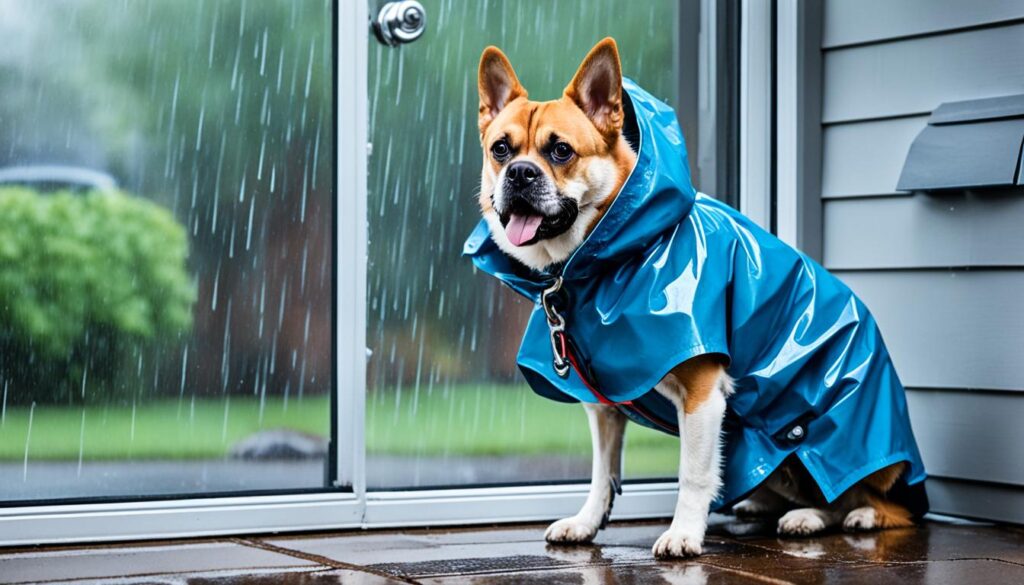
Addressing Gear Issues: Harnesses and Collars
Let’s talk tethers—that’s harnesses and collars, for the uninitiated. Every fur-parent’s dream is gear that promises snugness without the strangle, ease without the chafe. Think of your dog’s walking gear as their outfit of the day; it has to fit just right. Too tight, and they’re the damsel in distress in a corset’s clutch. Too loose, and it’s the toddling tot in grandpa’s galoshes. The Goldilocks of dog walking gear is what we’re after—the “just right,” if you will. So let’s check out the bounty of options available for holding your hound.
Understanding Your Dog’s Response to Weather Extremes
Now, onto Mother Nature’s capricious whims—the dog days of summer and the chills of winter. When the sun plays scorcher, or the winter wind howls like a chorus of coyotes, consider your canine’s comfort. Hot sidewalks can scorch those precious paws, and icy blasts turn a stroll into a frosty fiasco. It descends to this simple truth: if you’re sweating through your shorts or shivering in your shearling, chances are your furry friend is equally unenthused about braving the extremes. Always check the forecast, and plan your promenades accordingly.
| Weather Condition | Dog Gear Consideration | Comfort Tips for Dog Walks |
|---|---|---|
| Sweltering Heat | Breathable mesh harness | Walk during cooler hours, provide constant access to water |
| Rainy Days | Waterproof jacket and collar | Keep trips short, dry off paws post-walk |
| Bracing Cold | Insulated harness, paw protectors | Choose sunny, midday walks, consider a doggie sweater |
For doggos grumbling at gusts of wind or paws perspiring in the summer blaze, offering them a reprieve is not just kindness—it’s dog-gone common sense. Whip out that cool harness when the mercury rises or strap on those booties when Jack Frost starts nipping. Your pup will soon stride alongside you, blissful in the face of whatever Mother Nature fancies!
Motivation and Mood: Is Your Dog Merely Uninterested in Walks?
When the leash jangles like a dinner bell but your dog’s response is more “meh” than “yeah!”, consider this: could your dog’s walking enthusiasm be as lost as socks in a dryer? We’re delving into the realm of dog mood impacts on walking—because sometimes, the path to “heel” is through their happiness.
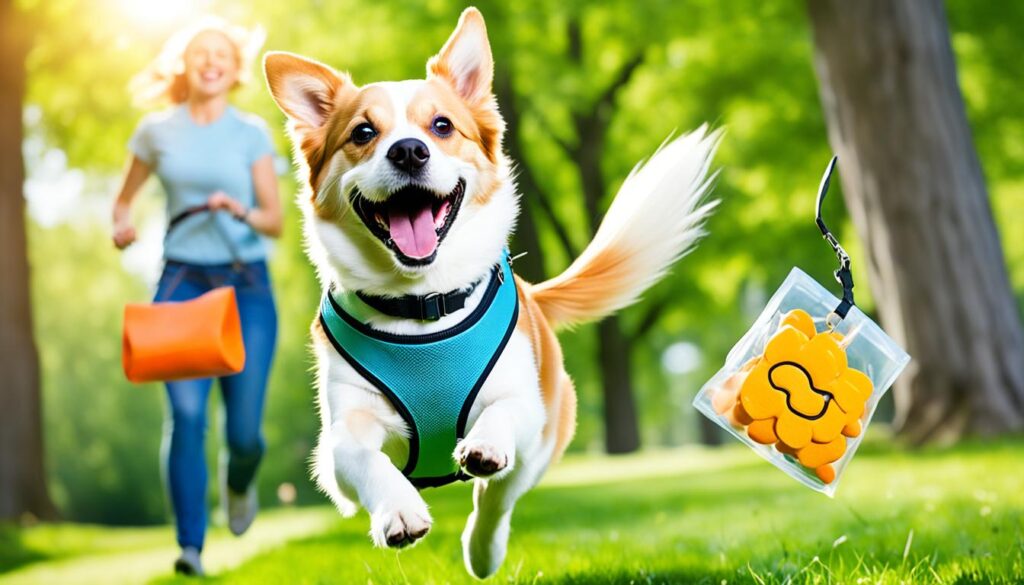
It’s not just about sniffing out health issues; a dog’s desire to dodge the daily promenade can be deeply rooted in mood and motivation—or lack thereof. The most gung-ho of tail-waggers might encounter a slump, trading frolics for flops. Understanding the factors behind these moments of malaise is like holding the leash to their motivation. Could it be post-meal sleepiness or perhaps a protest against leaving an exhilarating playdate behind? Maybe their woofing wish is for a walk-a-thon instead of a measly march around the block? It’s a conundrum worthy of consideration.
Why just trot when you can tarry and sniff the roses… or squirrel trails, as far as your dog’s concerned?
- Post-Meal Lethargy: Is your pooch snoozing when they should be schmoozing with the neighborhood’s fire hydrants? Timing is everything. A belly full of kibble can lead to nap demands.
- Leisure vs. Leaving: Like a toddler at Disneyland, your dog may balk at the idea of leaving a riveting environment. Why head home when there’s a carnival of sniffs here?
- Yearning for Marathon Walks: On the other end, some dogs might feel short-changed by a micro-mosey around the block. They’re primed and ready for the Canine Iditarod, and you’re offering a jog to the mailbox.
Identifying these subtle signs is akin to being a doggie mood ring—attuned to the shades of their spirits. Once pinpointed, a tweak here, an adjustment there, and voila, their walking whims are met, and you’re no longer coaxing a canine statue down the sidewalk. To decipher these riddles, consider crafting a table of observations:
| Time of Day | Pre-Walk Activity | Dog’s Response to “Walk” | Adjustment for Motivation |
|---|---|---|---|
| Morning | Post-breakfast chill | Play-dead performance | Delay walk for digestion |
| Afternoon | Mad fun at the dog park | Cling to park benches | Add more playtime pre-walk |
| Evening | Watching sunset with you | Snubs the leash | Choose a scenic route to inspire |
Hit the sweet spot that tickles your dog’s fancy, and you not only overcome dog walking refusal, you become the maestro of merriment on the move. Remember, your canine companion isn’t just being difficult—they’re casting a vote for a jazzier jaunt. Honor that, and they’ll lead the way with a pep that reads pure puppy poetry!
Dog Doesn’t Want to Walk: In-Depth Analysis and Solutions
Scratching your head over your four-legged friend’s dog walking resistance can be like trying to decipher Morse code without a key. As you eye the leash and then your unmoving pup, you may wonder: “To walk or not to walk, that is the question.” Well, the plot thickens, but here’s the twist: A mix of behavioral modification techniques and positive reinforcement could very well be the secret script to change the ending to a happier one.
Behavioral Modification Techniques for Increased Engagement
Gone are the days of simply standing, leash in hand, waiting for a miracle. Like a maestro tunes his instruments, behavioral modification helps you orchestrate your pupper’s participation in the daily promenades. Imagine transforming that stubborn mule into an eager beaver—with strategy! Start with engaging their curious noses; change up your usual routes to tease their interest. The scent of a fresh adventure can rev the engine of even the most laid-back bow-wow.
“The only way to get over a dog’s fear is to walk straight through it.” — Quite probably what a Ph.D. in Dogology would say.
Next up, sprinkle in a dash of command-based interaction. A sprightly “Let’s go!” coupled with a pointed gesture could work wonders. Interactive walks aren’t just about burning calories; they’re mental gymnasiums for your canine companion. Who knew that dog walking could double as a brain game?
The Power of Positive Reinforcement in Walk Training
Time to channel your inner Pavlov, because we’re talking treats, baby! Every step taken is an opportunity for celebration. Positive reinforcement in dog walking is like the yellow brick road; follow it, and you’ll uncover courage, brains, and maybe even a way back to Kansas. Emotional currency is rich; break out a treat for each desired behavior. And hey, that pocketful of yum isn’t bribery; it’s motivational currency.
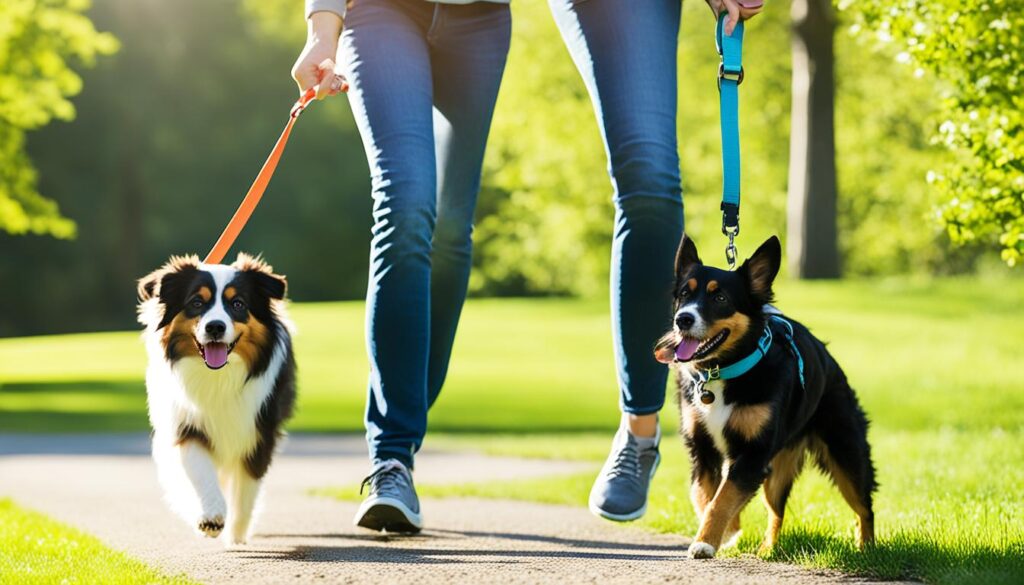
A few morsels of snack-time favorites every time they heel like a champ piles on the encouragement. Each small win is a checkpoint en route to overcoming walking refusal—a triumph not just for their fitness but for their confidence. Who knew kibble could unveil such canine courage?
And if the thought of accidentally turning your dog into a treat vacuum is unsettling—breathe. It’s a stepping stone, not a forever meal ticket. As their fondness for biped excursions grows, you’ll find their reliance on the tidbits diminishing. Instead, they’ll be feasting on the thrill of exploration and your shared experiences.
- Treats: The carrot leading them towards valiant ventures
- Commands: The staff that parts the seas of sedentary
- Consistency: The journey of a thousand miles—or just to the park—begins with a single, well-rewarded step
The art of dog walking, much like fine wine and good storytelling, gets better with time. With a twist of ingenuity, a pinch of patience, and a vault of treats, the next chapter in your quests on leash can certainly be one for the books. Let the resistance crumble and watch as your four-pawed pal turns into a wandering epicurean, sniffing out the path less traveled—one joyous trot at a time.
Establishing a Routine: Consistency in Dog Walking
When it comes to nurturing a consistent dog walking routine, it’s like baking the perfect loaf of sourdough; it’s all about a reliable pattern and regularity. Instilling a dog exercise routine isn’t a sprint, but more of a delightful daily dance with your pup, one that instills a spring in their furry step and sparks joy in their doggy cardio.
Imagine a world where the very whisper of a leash sends your canine companion into a tail-spin of anticipatory delight. Why? Because you, oh wise pet guru, have laid the groundwork with a steady dog exercise routine that’s as predictable as the sunrise—and quite possibly, just as welcomed.
| Time of Day | Action | Result |
|---|---|---|
| Morning | Sunrise stroll | Starts the day with energy |
| Afternoon | Post-nap jaunt | Breaks day into manageable chunks of delight |
| Evening | Night-time meander | Winds down the day with calmness |
The table above isn’t just a piece of eye candy; it’s the blueprint to transforming your unpredictable pooch into a creature of habit. Each walk is a chapter in the ongoing narrative of your dog’s day. Regularity reigns supreme as you establish a rhythm that rivals the natural order—wake, walk, eat, play, sleep, repeat. And when life throws a curveball, as it so often does, this consistency acts as the cozy blanket of predictability in your dog’s world.
Fido’s internal clock will soon chime in harmony with your walking schedule, knowing full well that after the chirping of birds comes the jingle of the leash. It’s poetic, really, and as the strolls become ingrained, so does a paw-sitive outlook on life’s little jaunts. So, lace up those sneakers, affix that leash, and stride forth. Your dog’s paws are ready to tap out the rhythm of routine on every sidewalk, trail, and path!
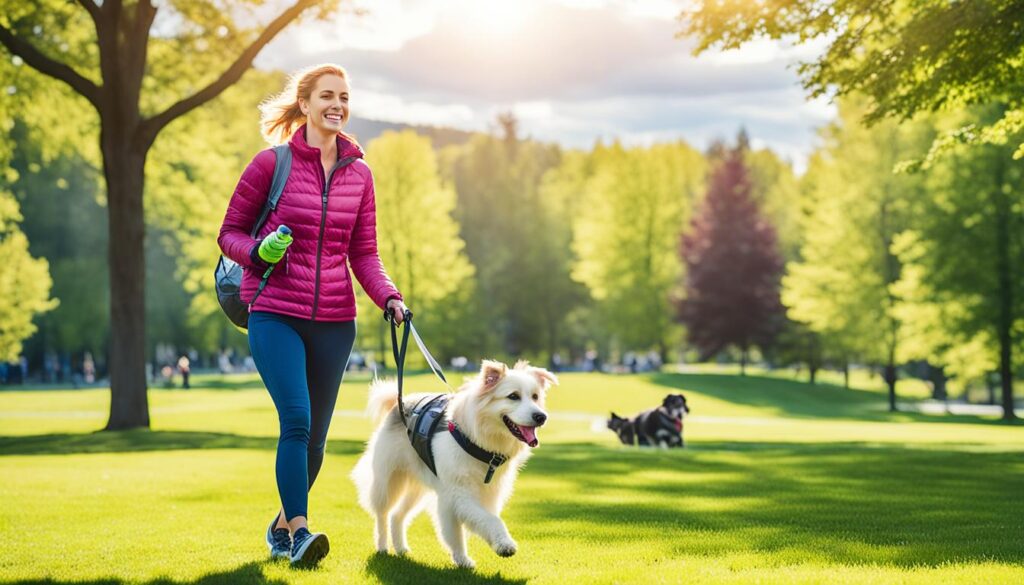
But wait, let’s not simply list off the dance steps without a nod to the dance floor itself. Just as dancers need a good stage, so too do dogs require fitting surroundings. Choose pathways that invigorate both you and your dog—after all, a pleasing environment is the cherry on top of this well-crafted exercise routine sundae.
- Morning: Bask in the soft glow of dawn to jumpstart those sleepy canine senses.
- Afternoon: Navigate the nooks of your neighborhood; a game of ‘sniff and discover’ adds spice to the daily dog trot.
- Evening: A gentle moonlit mosey? Pure magic for tucking in those tired pups.
Now take a bow, for you’ve cracked the code to curbing canine capriciousness. Stay the course, and soon enough, your dog’s less “why walk?” and more “let’s rock this walk!”
Engaging a Professional: When to Consult a Dog Walker
As much as we love our four-pawed companions, there comes a time when even the most devoted dog owners can use a helping hand. That’s when the super-powers of a professional dog walker come into play. Remember that even dogs get bored of the same ole, same ole. So why not spice up their life with the zesty zeal of a pro strutter?
The Benefits of Outsourcing to Dog Walking Services Like ‘All For Furry Friends’
Turning to the seasoned footsteps of ‘All For Furry Friends’ dog walking services doesn’t just spell relief for your crammed calendar; it spells a whole new world of tail-wagging happiness for your hound. From the monotonous march to the brisk, stimulating sprints, these wizards of walkies know just how to keep your pup’s paws prancing with pep.
- Routine Refresh: Professional dog walkers throw in that splash of pizzazz that transforms routine into exhilarating escapades.
- Social Butterfly Time: They’re the ultimate wingman for your dog, facilitating furry friendships and romps around the park.
- Perk Up Those Paws: Dogs look forward to their time with a walker, and the excitement is contagious—even you’ll feel it!
How a Dog Walker Can Revitalize Your Dog’s Walking Attitude
The charm of a professional dog walker lies in their doggo-whispering skills that can turn the most stubborn of walk-refusing pooches into an eager explorer. With a pinch of strategy, a sprinkle of experience, and boundless enthusiasm, they’re not just walking your dog; they’re unlocking the secret realms of your dog’s untapped zeal for the great outdoors.
- Mix It Up: New routes and neighborhoods mean an all-you-can-sniff buffet for your dog’s senses.
- Happy Hearts Club: The health benefits soar with a pro on board—your pup’s heart is pumping, and their spirits soaring.
- Stress Busters: A consistent walking buddy turns anxiety into anticipation and makes every bark a little cheerier.

Now imagine your canine Joe Cool, strolling down the avenue, turning heads and sniffing every enigmatic nook, all with a pro by their side—yes, folks, the tail tells a tale of contentment! So when you’re swamped, or your dog’s in need of novelty, don’t hesitate to call on the high priests of pavement pounding—the professional dog walker.
The Role of Health Check-ups in Your Dog’s Walking Behavior
It’s not just about the frisbee flinging and the belly rubs; your dog’s health is paramount, especially when it seems like their paws are glued to the ground during walk time. A stitch in time saves nine, and likewise, regular veterinary health check-ups can work wonders in keeping those canine capers ongoing. Think of your vet as the detective who unravels the mystery behind your pooch’s sudden walking strike.
A comprehensive pet mobility assessment might just reveal subtleties in your dog’s limb language that are screaming for attention. It’s like translating Morse Code into a clear “My hips hurt” or “I think my paw is injured.” But, without the decoder ring that is professional medical insight, you might just be left scratching your head in bewilderment.
Importance of Regular Veterinary Visits for Mobility Assessments
Let’s dive into the why, shall we? Regular vet visits are like the oil changes of the dog world—preventive, proactive, and oh-so necessary. During these checkups, your vet can play detective, looking for clues like joint tenderness or hesitancy in their stride that could point to bigger mobility issues. It’s about nipping potential problems in the bud before your dog decides to go on a walking strike.
When to Seek Medical Advice for Your Dog’s Walking Resistance
But when do you go from shrugging off your pup’s lethargy to dialing up the vet? Well, if phrases like “walking refusal” and “sudden onset of laziness” are becoming common in describing your dog’s behavior, it’s definitely time to seek medical advice for walking refusal. Whether your dog is throwing in the towel mid-walk or just not bouncing around at the jingle of the leash, prompt medical intervention can save the day by addressing issues proactively.
Don’t let your furry friend’s walking woes become the norm. Keep those tails wagging, and paws padding along your favorite walking trails with timely veterinary health check-ups and mobility assessments. After all, a happy dog is a walking dog!
Conclusion
As we’ve journeyed through the twist and turns of dog walking dilemmas, it’s evident that a dog doesn’t want to walk for multiple reasons—each as individual as the dog itself. Pinning down the ‘why’ in your dog’s walking strike is akin to unraveling a leash that’s knotted itself into a conundrum. It requires not just keen observation but a steadfast commitment to understanding and addressing the root of the resistance. Whether it’s joint pain whispering its limits, anxiety casting a shadow, or the call for more engaging and consistent walk routines, every clue is a step towards a solution.
In the search for reliable dog walking solutions, remember that the golden bones to success lie within patience, persistence, and professional insight. Services like ‘All For Furry Friends’ are your alleys in freeing your pup from the shackles of walking refusal, infusing daily jaunts with joy and vigor. Embrace the spectrum of strategies, from slow and steady leash training to the welcome novelty a professional walker brings, and watch your dog rekindle their love for exploration—one paw at a time.
So, take heart, diligent dog owners. With thoughtful analysis, a sprinkle of creativity, and a dollop of love, walking can transition from a drag-laden duty to the highlight of your dog’s day. The path to a gleeful, tail-wagging, four-legged trotter is paved with the treats of nurture, the leash of guidance, and an unwavering passion for the well-being of your loyal companion. Here’s to walks filled with boundless enthusiasm, sniff-worthy adventures, and shared moments that turn into cherished memories.
